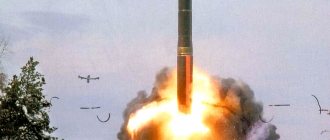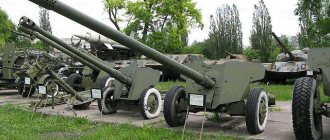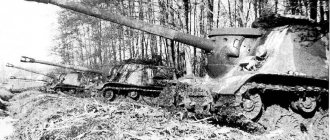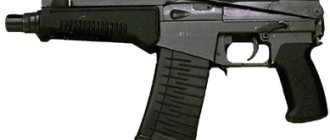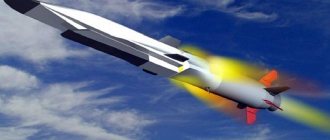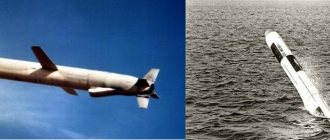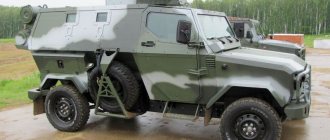The consistent development of the Topol and Topol-M mobile strategic missile systems led to the creation of the RS-24 Yars complex. The complex was developed by the Moscow Institute of Thermal Engineering. The first test launch of the complex rocket was carried out on May 29, 2007. Serial production was launched at the Botkin Machine-Building Plant. The complex will replace complexes with intercontinental ballistic missiles RS-12, RS-18 and RS-20 on duty as their warranty periods expire. The re-equipment of the strategic missile forces with Yars missile systems is proceeding at a relatively fast pace. According to Russian media reports, by 2025, 4 of the 12 missile divisions in the Strategic Missile Forces will be armed with RS-24 Yars complexes.
A regiment of Yars mobile systems usually includes two or three missile divisions, each of which has three self-propelled launchers and a mobile command post on an MZKT chassis. The 15P165M stationary missile system includes 10 15Zh67 Yars-M intercontinental ballistic missiles, placed in transport and launch containers and installed in silo launchers 15P765M silos (converted 15P735 silos of 15A35 missiles), as well as a highly secure unified command post (UCP) 15V242 ( located on a suspension in the shaft with special shock absorption). The 15P155M mobile ground-based missile system (GGRK) includes 9 15Zh55M intercontinental ballistic missiles mounted on 15U175M autonomous launchers (APU). The autonomous launcher 15U175M of the mobile complex consists of a 15ZH55M missile placed in a high-strength fiberglass transport and launch container (TPK), mounted on an eight-axle MZKT-79221 chassis. A missile regiment (RP) consists of a mobile command post (MCP), three missile divisions (RDN) with 3 APUs each, a total of 9 APUs in a missile regiment, as well as an engineering support and camouflage vehicle (MIOM).
In its design, the RS-24 intercontinental ballistic missile of the Yars complex is generally similar to the RS-12M2 missile of the Topol-M complex and is maximally unified with it, with the exception of the block deployment platform, head fairing, control system and payload. RS-24 is a three-stage solid propellant rocket. Its body is made of high-strength composite material based on aramid fiber. The rocket does not have stabilizers for flight control. Their function is performed by the engine nozzles of each stage. Nozzle tips and nozzle block bells are also made of composite materials. The rocket has an inertial flight control system. All information is processed by the on-board computer complex, which can correct the flight, taking into account information from the GLONASS navigation satellites.
For mobile launchers produced by the Minsk Wheel Tractor Plant and 15Zh55M - for silo launchers (silos). In this regard, it should be noted that silo launchers of UR-100 NUTTH (RS-18B) and RT-23 (RS-22) missiles, withdrawn from service or destroyed in accordance with the START-2 treaty, are used to deploy 15ZH55M missiles. A project has also been developed for using silo launchers on the R-36M UTTH (RS-20A) and R-36M2 (RS-20B) missiles. The launch of the RS-24, both mobile and silo-based, is a mortar launch using a powder battery.
Technical characteristics of PC-24 "Yars"
"Yars" is the newest domestic missile system, put into combat operation 5 years ago. Most of the information about the RS-24 Yars missile is still a state secret.
Following "Topol"
Launch silo RS-24 "Yars"
RS-24 "Yars" is a further development of the theme of mobile ground-based missile systems, which the Moscow Institute of Thermal Engineering, headed by Academician Yuri Solomonov for many years, began to develop. The first experience turned out to be extremely successful. Its result is well known today - this is the Topol-M complex, which has been an integral component of nuclear parity for more than 20 years.
Like the Topol, the Yars was created in two versions - mobile and stationary mine. The Russian Army command plans to gradually replace (as its service life expires) the RS-18 and Topol-M systems in service with Yars. In 3 years, the strategic missile group will be replenished with new Sarmat complexes.
Notes
- ↑
- . Rocket technology. Retrieved June 30, 2020.
- ↑
- (unavailable link). Retrieved July 18, 2013.
- Oleg Gertsev.
(unavailable link). All-Russian weekly newspaper “Military-Industrial Courier” (March 17, 2009, 17:03). Retrieved December 23, 2009.
- . ITAR-TASS (April 14, 2014). Retrieved April 14, 2014.
- . Interfax. Retrieved September 12, 2020.
- Alexander Peshkov.
. TV channel "Star". Retrieved October 11, 2020.
- ↑. Yars. Retrieved December 17, 2020.
- (unavailable link). ARMS-TASS (April 13, 2010). Retrieved August 14, 2010.
- (unavailable link). Website Vesti.Ru (July 19, 2010, 15:55). Retrieved July 19, 2010.
- Error in footnotes?: Invalid tag; no text provided for footnotes
- (unavailable link). Of. website of the Ministry of Defense of the Russian Federation (January 2, 2012). Retrieved January 5, 2012.
- . Voice of Russia (December 14, 2012). Retrieved December 16, 2012.
- . TASS
(November 13, 2017). Retrieved March 11, 2020.
- ↑
- . Russia Today
(May 28, 2018). Retrieved May 30, 2020.
Increased Power
For each version of the Yars, corresponding types of missiles have been developed - 15Zh67 for the mobile and 15Zh55M for the silo complex. Both rockets are three-stage solid fuel. Compared to the RS-12M2 (Topol-M) missile, the RS-24 is equipped with a more advanced warhead deployment system and a modified control system. The missiles of the complex are also constantly located in the transport and launch container.
Thanks to special coatings, the products are reliably protected from the damaging effects of a nuclear explosion and remain invisible to radar. The rocket's autonomy in flight is ensured by the on-board digital computer. During the final phase of the flight, the combat units are separated, which, as a result of complex maneuvering, become inaccessible to missile defense systems.
The RS-24 missile hits enemy strategic targets located 12 thousand km away. possible deviation of no more than 150 meters. Possible combat equipment options are 4 individual targeting units of 300 kt or 6 of 150 kt.
Classification of Russian missiles
Combat missiles are unmanned aerial devices that deliver destructive weapons to a target by flight on a jet engine.
There are five classes of missiles:
- earth-earth;
- ground-to-air;
- air-ground;
- air-to-air;
- air-surface.
In turn, there are different types of surface-to-surface missiles:
- along the flight path - ballistic and winged;
- by purpose - tactical, operational-tactical and strategic;
- by range.
Earth-earth
Russian surface-to-surface missiles are launched from missile systems (RMS) located in silos, on the ground or on ships, and are designed to destroy surface, ground and buried targets.
Launches of such missiles are possible both from fixed structures and from mobile self-propelled or towed installations.
Previously, the missile forces were armed with mainly unguided rockets (NURS). New surface-to-surface missiles are created and manufactured to be controllable, equipped with equipment that regulates their flight and ensures achievement of the target.
Earth-to-air
Anti-aircraft missile system S-400
The surface-to-air class combines anti-aircraft guided missiles (SAMs) designed to destroy air targets, mainly enemy combat and transport aircraft.
Based on the method of launch and control, there are four types of missiles:
- radio command;
- radio-guided;
- homing;
- combined.
Also, surface-to-air missiles differ in aerodynamic features, range, height and speed of air “targets”.
An illustrative example of Russian missile defense systems is the S-400 anti-aircraft systems with medium- and long-range missiles, which are involved in the scandal with the planned delivery to Turkey, which caused strong objections from the United States.
Air-ground
Air-to-ground - missile weapons for destroying ground and buried targets, which are in service with bomber and attack aircraft. By purpose and range they are classified similarly to surface-to-surface missiles. By type of target, they additionally distinguish anti-tank air-to-ground missiles for attacks on enemy armored vehicles and anti-radar missiles for disabling radar stations (radars).
Air-to-air
Air-to-air missiles are weapons of Russian fighter aircraft, designed to destroy manned and unmanned enemy aircraft.
By range there are:
- small - to strike a target visually detected by the pilot;
- medium - to hit a target at a distance of up to 100 kilometers;
- large - for launching over a distance of over 100 km.
Guidance systems for launching air-to-air missiles use radio command (in the USSR K-5 missiles), active and semi-active radar (ARLS - in the R-37, R-77 and radar radar - in the R-27), infrared (in the R-60 missiles and R-73).
R-27 air-to-air missile
Air-to-surface
Air-to-surface missiles, which are not air-to-surface missiles, are anti-ship weapons.
It is characterized by:
- relatively large mass;
- high-explosive type of destructive agent;
- radar guidance.
For more information on modern Russian anti-ship missiles, see below.
Support systems
The mobile version of the Yars is installed on a 15U175M tractor with a multi-axle chassis MZKT-79221. It is equipped with an 800-horsepower YaMZ-847 diesel engine. The mobile launcher is equipped with a navigation system, communication system, launch control equipment, autonomous power system, hydraulic leveling system, and container placement boom.
The tractor has an 18-meter turning radius and can ford a depth of more than a meter. It moves at a speed of 45 km/h and can make a 500-kilometer march. The length of the rocket is 22 meters, the launch weight is about 47 tons, the weight of the delivered charges is about 1.2 tons.
Types of Russian missiles
Intercontinental ballistic missiles
Based on the type of deployment, intercontinental ballistic missiles (ICBMs) are divided into those launched:
- from silo launchers (silos) - RS-18, PC-20;
- from mobile launchers based on a wheeled chassis - “Topol”;
- from railway devices - RT-23UTTKh “Molodets”;
- from the sea/ocean bottom - “Skif”;
- from submarines - “Bulava”.
Intercontinental ballistic missile RS-20
The silos used today perfectly protect against the damaging factors of a nuclear explosion and camouflage preparations for launch quite well. Other methods of deploying missiles guarantee high mobility and, accordingly, are more difficult to detect, but limit the army and navy in the size and weight of ICBMs.
High precision cruise missiles
Five of the most dangerous domestically produced cruise missiles:
- Family "Caliber". They primarily attack the personnel and infrastructure of “opposition” militants and outright terrorists in Syria. Development, which started in the 1980s on the basis of the strategic nuclear 3M10 and the anti-ship Alpha, was completed in 1993. In NATO they are codified as Sizzler. The strike range against offshore targets is up to 350 km, against coastal targets – up to 2600;
- Strategic air-to-ground missile X-101 (variation with a nuclear warhead - X-102). Designed by KB "Raduga" by 2013. It was also used in Syria for the above purposes. Mainly included in the armament kit of Tu-22 and Tu-160 bombers. The exact parameters of the X-101 are hidden from the public, but according to unofficial information, its maximum range is about 9 thousand km;
- Anti-ship P-270 “Mosquito” (NATO codified as SS-N-22 Sunburn). Created in the 1970s in the USSR. Can sink any ships with a displacement of up to 20 thousand tons. Range - up to 120 km along a low-altitude trajectory and 250 km along a high-altitude trajectory. To overcome the air defense (missile defense) system, it makes a “snake” maneuver;
- Strategic aviation X-55, air-to-ground class - for Tu-95 and Tu-160 bombers. It moves at subsonic speed, skirting the landscape below, making interception much more difficult. The power of the explosion is more than 20 times greater than that of the notorious Little Boy dropped by the Americans on Hiroshima in 1945;
- P-700 "Granit" is a long-range anti-ship missile designed to defeat large enemy ship and ship-aviation groups. Hit objects at a distance of up to 550 km. The heavy cruiser-aircraft carrier Admiral Kuznetsov, among others, is armed with P-700 devices.
Launch of the P-700 Granit anti-ship missile
Anti-ship missiles
In addition to the above-mentioned cruise anti-ship missiles, it is necessary to note the X-35 missile together with the Uran missile launcher, created in 1995 by the state.
The X-35 is capable of sinking ships with a displacement of up to 5 thousand tons. Thanks to its compact dimensions and low weight, it is used as weapons for ships of any class, including corvettes and boats, as well as weapons for various aircraft, including helicopters and light fighters. Coastal missile launchers "Bal" have been created for X-35 launches.
Russian aviation missiles
A particularly formidable asset of the Russian Air Force is the modernized variation of the R-37M Strela. This guided air-to-air missile is No. 1 in range in the world.
It is codified by NATO as the AA-13 "Arrow".
Used as a weapon:
- Su-27 heavy fighters;
- super-maneuverable Su-35 fighters;
- MiG-31BM fighter-interceptors.
The unique properties of the R-37M are dynamic instability and highest maneuverability. They allow it, bypassing all enemy anti-missile defenses, to hit a flying target that has approached the fighter at 300 kilometers or less.
According to a number of military experts, the R-37M and the similar Chinese PL-15 are capable of easily shooting down American aerial tankers that support non-stop flights of their strategic bombers, as well as reconnaissance, control and electronic warfare (EW) aircraft. Victories in today's wars are simply impossible without the listed auxiliary aircraft, while the effectiveness of the latest air-to-air missiles from Russia and China deprives the United States of an advantage in the air.
The supernova domestic air-to-surface weapon is the Kh-47M2 Kinzhal hypersonic missile, designed to destroy ground and surface targets. According to authoritative media reports, the Kinzhal RK is an aircraft modification of the Iskander family. The range of a device with a 500-kg warhead is determined by the properties of the bomber and ranges from 2 thousand to 3 thousand kilometers.
MiG-31 aircraft with Kh-47M2 "Dagger" missile
Last decades of the last century
In the last century, in the 80-90s, the Strategic Missile Forces were armed with five types of light ICBMs and their versions. These include solid fuel and liquid rockets.
It should be noted that the current costs of standardized installations are much lower than the same indicator for a set of light-class ICBM models. But in some respects the effectiveness of the latter is superior to Yars.
For example, the RS-18B liquid-fueled ICBM carries a more impressive MIRV in comparison with the RS-24. Its combat equipment is still being improved. The survivability of ICBMs is considered a separate issue, with the ground method being inferior to at least the railway method.
Taking into account the above facts, as well as the need to maintain parity in installed warheads and their carriers (in accordance with strategic offensive weapons treaties), since 2009, work has been underway to develop a domestic heavy-category liquid-fueled ICBM instead of the RS-20B (“Voevoda”). In general, the question of returnable reserves and the selection of RS-22V ICBMs remains open for Russia.
It is interesting that the productivity indicators of ICBMs have a political element attached to them—the “race” of strategic weapons, which is initiated by measures to protect against a nuclear attack—missile defense (BMD). In 2002, the United States terminated the 1972 treaty on the reduction of missile defense systems. This country is creating a new promising missile defense system, including its segments in Europe. The system has been implemented since 1991. The creation of America's national missile defense system was formalized by law; in 1999, the first testing of its elements was carried out.
"Yars"
We continue to find out further what a “Yars” (rocket) is. Its characteristics deserve close attention. The adoption of this projectile in the context of America's buildup of missile defense capabilities became probable, since the START-1 agreement expired in 2009, which allowed the development of ICBMs only with a monoblock leading part.
What was Russia's second asymmetric response to US missile defense initiatives? The Yars rocket had a very effective flight speed. In addition, its excellent stability when passing through the ranks of the promising US missile defense system was striking. And it was not influenced by the damaging factors of nuclear explosions (PFYE).
Many experts claim that the Yars-M missile has excellent characteristics. Thus, the active trajectory area of this weapon is reduced. An instant increase in speed provides a more efficient mixture charge of the rocket's solid propellant propulsion engines (SDTT). The projectile can perform a program maneuver at launch. It is necessary to penetrate the nuclear explosion cloud of an attacking missile.
It is interesting that the Yars, unlike the previous RS-12M, uses a guidance system that does not respond to powerful electromagnetic pulses. In general, the latest missile defense countermeasures systems (CSS) significantly reduce the likelihood of the leading department being captured.
It should be noted that KSP decoy targets cannot be distinguished from military units in the electromagnetic phonation zone. With their help, it is possible to falsify parameters for almost every selection characteristic in the extra-atmospheric, transitional and large areas of the atmospheric segment of the descending branch of the trajectory of the leading part.
Here, for the first time, fake targets are used, which have super-resolution and are able to ignore radar. KSP means that distort the parameters of the head zone are created from a radio-absorbing shell, dynamic radio interference generators, aerosols that are sources of infrared radiation, and so on.
Events of World War II
It is interesting that Nazi Germany was the first to begin work on creating ICBMs. In the summer of 1942, Wernher von Braun led the launch of Project America, which would create the A9/A10 rocket. Experts have developed a two-stage liquid fuel charge weighing one hundred tons, capable of flying over a distance of up to 5,000 km.
It is known that according to the current classification, A9/A10 formally refers to medium-range charges. But it was developed as an intercontinental munition capable of hitting the east coast of the United States. Technically, the A9/A10, however, was not a ballistic missile, as it was equipped with an upper winged stage, de facto appearing as a cruise supersonic weapon.
This charge was aimed at the beginning and middle of the flight using radio beacons. They were aimed at the target in advance and activated by the pilot at the right moment, in the finale. A person carrying out such an important mission, shortly before the target, left the small cabin by parachute and landed on the surface of the Atlantic Ocean after making a suborbital space flight.
Some sources report that tests to develop the A9/A10 were carried out on January 8 and 24, 1945, but it was not used in combat.
Other sources say that work on the program never progressed beyond sketches (which is more plausible). By the way, the Germans underestimated the intricacy of gliding flight at supersonic speed, which is perhaps why the A9/A10 system would never have been able to work.
After the defeat of Germany, America and the USSR removed from its territory a colossal amount of documentation, experts and material resources for missile research.
RS-24 Yars / Topol-MR
Intercontinental ballistic missile (ICBM) / mobile ground-based missile system (MGRS).
The complex and the missile were developed by the Moscow Institute of Thermal Engineering (MIT) on the basis of the RT-2PM2 / Topol-M ICBM, the chief designer is Yu. Solomonov. The development of the Topol-M / RT-2PM2 ICBM using only Russian technologies began in March 1992. The decree of Russian President B.N. Yeltsin on the creation of the Topol-M missile system (with development options) was issued on February 27, 1993. The first test launch was carried out on May 29, 2007 from a mobile launcher at the Plesetsk test site. The complex was accepted into “experimental combat operation” in the Strategic Missile Forces in December 2009. In January 2010, it was announced that state tests of the complex would be completed before the end of 2010, or after the 4th and 5th launches. The missiles of the complex are produced at the Votkinsk Machine-Building Plant (Votkinsk). According to media reports (2010), RS-24 missiles will be replaced on duty by RS-18 and RS-20 ICBMs as their warranty periods expire. From 2012, only the RS-24 Yars ICBM is planned to remain in serial production. In 2011, it was planned to carry out 3 test launches of the Yars ICBM (media reports from December 2010). All data on the complex is speculative and taken from open sources and the media. A list of sources is attached. The rocket indices 15Zh55M or 15Zh67 are speculative.
APU 15U175M of the RS-24 Yars complex with an ICBM 15Zh55M at an ICBM demonstration to journalists in the Teikov division on November 29, 2011.
(photo - Sergey Pyatakov, https://visualrian.ru/). One of the versions is that the RS-24 missile is a variant of the 15Zh65 missile of the RT-2PM2 Topol-M complex with a platform for breeding warheads of a new type (presumably the Topol-MR design and development project - source - OJSC "Corporation..."
). The 15Zh65 missile was developed jointly by MIT and the Yuzhnoye Design Bureau according to the decision of the USSR Military Industrial Complex No. 323 of 09.09.1989 on the topic of the Universal research project until the end of 1991 in two versions - a missile with a platform for breeding unguided warheads with a solid propellant rocket engine and without a set of means overcoming (KSP) missile defense was developed by MIT (mobile missile system), and a similar missile with a platform for breeding warheads with a monopropellant liquid engine and with a missile defense KSP was developed by the Yuzhnoye Design Bureau (Dnepropetrovsk, silo missile complex 15P065). The development of the 1st stage, a version of the AP launch platform and the rocket's nose fairing was led by the Yuzhnoye Design Bureau, the development of the 2nd and 3rd stages, the instrument compartment, its version of the AP launch platform and the unguided warhead was led by MIT. The first flight sample of the 1L version of the missile from the Yuzhnoye Design Bureau was ready for testing at the test site in Plesetsk in December 1991. The sending of the missile to the test site was canceled by the decision of the Commander-in-Chief of the USSR Strategic Missile Forces. In 1992, after the general designer of the Yuzhnoye Design Bureau S.N. Konyukhov addressed the President of Russia B.N. Yeltsin, a meeting was convened to discuss the continuation of the joint development of ICBMs. No decision was made, and in April 1992, Yuzhnoye Design Bureau’s participation in the development of the rocket was terminated. After that, developments on the RT-2PM2 version with a missile defense system and a monopropellant engine of the breeding platform were transferred from the Yuzhnoye Design Bureau to the Moscow Institute of Thermal Engineering. A sample of the 1L rocket was transferred to Russia on January 15, 1995.
Deployment
“Yars” complexes began in December 2009 after the adoption of the Strategic Missile Forces complex for “experimental combat duty” as part of one missile division of the Teikovsky regiment of the 54th Guards Missile Division of the 27th Guards Missile Army of the Strategic Missile Forces (based in Krasnye Sosenki, 3 complexes) .
On November 30, 2010, the Commander-in-Chief of the Strategic Missile Forces, General S. Karakaev, stated that the Strategic Missile Forces would gradually rearm from mobile complexes with single-block Topol-M missiles to mobile complexes with missiles with MIRVs IN "Yars". In December 2010, the second division of Yars complexes (3 SPU) entered service with the Teikov missile division. On March 4, 2011, it was announced that the first missile regiment with the RS-24 Yars ICBM took up combat duty in the Strategic Missile Forces as part of the Teikov division. The regiment of the Teikov missile division included 2 missile divisions of RS-24 ICBMs, delivered to the Strategic Missile Forces in 2009-2010. In total, the regiment has 6 RS-24 complexes. On July 6, 2011, in an interview with the media, Yuri Solomonov stated that as of July 2011, there was no contract under the state defense order for 2011 for the production of Yars missiles and any other ICBMs. Earlier, the media announced the completion of the recruitment of the first regiment of the Yars ICBM and the beginning of training of personnel of the second regiment of the Yars ICBM of the Teikovsky missile formation. On August 3, 2011, the third division of Yars complexes took up combat duty as part of the regiment of Yars complexes of the Teikov missile division. Thus, the first full-time three-division ICBM regiment “Yars” was formed. On September 27, 2011, information appeared on the website of the Russian Ministry of Defense that by the end of 2011, the second Yars ICBM regiment would go on combat duty in the Teikovsky division of the Strategic Missile Forces. And finally, on December 7, 2011, in the Teikov missile division, the second missile regiment of the Yars complexes was put on experimental combat duty as part of a mobile command post of the regiment and one missile division. It is expected that another division of this regiment will be put on combat duty by the end of 2011 (2 or 3 APU?). The complete re-equipment of the regiment with the Yars complexes will be completed in 2012 (completed in September 2012). In 2012, work will begin on re-equipping the Novosibirsk and Kozelsky missile formations with the same complex. Moreover, in the last of them, the deployment of Yars complexes will be carried out in a silo version
(planned to begin in 2014). In the future, it is planned to re-equip a number of more missile formations with the Yars missile system.
On December 26, 2013, information was released that a new silo-based missile system was being put on duty - probably it was about the fact that it was decided to adopt the silo-based Yars ICBM complex for service with the Strategic Missile Forces. Presumably the new missile system is called Yars-M.
On December 19, 2011, it was announced that by the end of 2012, one regiment of the missile division of the Strategic Missile Forces in Pashino (Novosibirsk) will be rearmed with ICBMs of the Yars complexes. On November 20, 2012, also in the media, the commander of the Strategic Missile Forces, Colonel General Sergei Karakaev, stated that in December 2012, the sixth regiment of the Tatishchev division of the Strategic Missile Forces would be re-equipped with the Topol-M silo-based ICBM complexes, and during 2013. The Yars and Topol-M complexes will re-equip units of three more divisions (Irkutsk, Novosibirsk and Kozelsk - the latter with the installation of silo versions of the Yars ICBM). Preparations for the re-equipment of divisions in Novosibirsk and Kaluga (Kozelskaya) began in 2012.
During 2011, the MIT corporation carried out technical re-equipment for serial production and testing of components for the Topol-MR / Yars complex (Agreement with Roscosmos No. 902-D162/11 dated 09/05/2011, investment volume in 2011 - 57 ,0 million rubles). Also, OJSC MIT Corporation, Vnesheconombank Bank and VTB Bank, with the participation of the Russian Government, reached an agreement on the provision in 2011-2014. funds in accordance with the government contract for the supply of the Yars product in the amount of 48,100,000 thousand rubles. By year: 2011 – 10,900,000 thousand rubles. 2012 – 11,700,000 thousand rubles. 2013 – 12,400,000 thousand rubles. 2014 – 13,100,000 thousand rubles. ( source - JSC "Corporation..."
).
In September 2012, it was publicly announced that a decision had been made to develop a modernized version of the Yars-M complex (source).
Combat control system
: On September 19, 2013, it was reported that the combat control system for ICBM launches of the Russian Strategic Missile Forces had begun to be modernized to a 5th generation system. With the adoption of the Yars ICBM in the Strategic Missile Forces, a 4th generation combat control system appeared, which significantly increased the range and probability of transmitting orders to the ICBM APU through the use of new means of communication. The use of advanced mobile control points will ensure stable, continuous and operational control of nuclear weapons, taking into account the characteristics of the combat use of both existing and future strategic missile systems in real time. The adoption and equipping of the re-equipped Strategic Missile Forces formations with a new automated combat control system (ACCS) will make it possible to begin modernization of existing stationary control points in the future. Along with this, starting in 2016, the Strategic Missile Forces, in cooperation with industry, plan to introduce elements of the fifth-generation integrated automated combat control system. It is based on a digital system for transmitting combat orders. The system will make it possible to quickly retarget missiles, as well as provide solutions to the problems of information support and management of the daily activities of the Strategic Missile Forces command, formations and formations. The collection of reports will be ensured by wired, radio and satellite communication channels, which have the necessary survivability and noise immunity. The latest ASBUs provide for the transmission of combat control orders directly to launchers, bypassing intermediate links, including in conditions of nuclear influence and electronic suppression (source).
The 15Zh67 Yars-M silo-based ICBM regiment is controlled using the 15B242 command complex located in a converted OS-type silo. In the Kozelsky missile formation (division), the first regimental complex 15B242 was installed instead of the dismantled outdated similar complex after the silo was re-equipped. Re-equipment and installation were carried out by the Federal State Unitary Enterprise "GUSST No. 5 at Spetsstroy of Russia" at least from the beginning of 2013. The installation of a unified control unit (UCP) in the mine was carried out on March 18-19, 2014 (source, source, source).
Installation of a unified command post of the silo-based 15B242 ICBM "Yars-M" complex in the missile regiment of the Kozelsky division of the Strategic Missile Forces, March 18-19, 2014 (https://gusst5.ru/).
Launcher:
Rocket 15ZH55M (presumably) - mobile APU (autonomous) 15U175M on a multi-axle chassis MZKT-79221 (Minsk, series since 2000), similar to the APU of the Topol-M complex. Perhaps a modification of the mine-based complex will be developed. The topographic location of the APU is carried out at any point on the patrol route automatically using an inertial navigation system with satellite correction. Presumably, the topographic reference system of the Yars APU differs from the similar system of the Topol-M ICBM APU. The APU equipment includes: — a navigation system with a complex for recalculating flight missions to ensure launch from any point on the patrol route; - a set of communications equipment that ensures guaranteed reception of combat control signals from the air defense device and the transmission of reports on the state of the automatic control system; — a set of combat launch control equipment; — autonomous power supply system (diesel generator); — an artillery unit (boom) for placing the TPK and making it ready for launch; — an appropriate hydraulic system to ensure leveling of the automatic launcher and lifting the boom; — appropriate equipment (system) to ensure the required temperature and humidity conditions (TVR) in the TPK and ground equipment compartments; — ground control system (equipment for preparation, start-up and condition monitoring of automatic control equipment); — aiming system with automatic gyrocompass (AGC);
Presumably an APU 15U175M of the Yars complex, shown under the guise of an APU of the RT-2PM2 / RS-12M2 Topol-M complex at a parade in Moscow, photo taken during a parade rehearsal in Moscow, May 04, 2010 (photo - Goodvint, https ://ru.wikipedia.org).
APU of the RT-2PM2 / RS-12M2 "Topol-M" complex with the Yars ICBM TPK during a parade rehearsal in Moscow, 04/26/2011 (photo - Vitaly Kuzmin, https://vitalykuzmin.net/).
APU of the RT-2PM2 / RS-12M2 "Topol-M" complex with the Yars ICBM TPK during a parade rehearsal in Moscow, 04/26/2011. Previously it was believed that this was the "Yars" APU, 05/03/2011 (photo - Andrey Kryuchenko, https://a-andreich.livejournal.com).
APU 15U175M of the RS-24 “Yars” complex with an ICBM 15Zh55M at an ICBM demonstration to journalists in the Teikovsky division of the Strategic Missile Forces, 09.22.2011. (photo by Andrey Smirnov, https://www.epochtimes.ru).
APU 15U175M of the RS-24 Yars complex with an ICBM 15Zh55M at an ICBM demonstration to journalists in the Teikov division on September 22, 2011. (https://www.mil.ru).
APU 15U175M of the RS-24 “Yars” complex with an ICBM 15Zh55M, 54th Teikovsky division of the Strategic Missile Forces, 09/22/2011. (https://muxel.aero).
APU 15U175M of the RS-24 “Yars” complex with an ICBM 15Zh55M, 54th Teikovsky division of the Strategic Missile Forces, 11/29/2011. (https://militaryphotos.net).
Chassis MZKT-79221 before the parade in honor of the Independence Day of the Republic of Belarus in Minsk, publication 07/01/2013 (https://www.vpk.gov.by via https://autocatalogue.livejournal.com).
Performance characteristics of the SPU on the MZKT-79221 chassis: Launch type - mortar using PADS Wheel formula - 16 x 16 Engine - diesel YaMZ-847.10 with a power of 800 hp, 4-stroke, 12-cylinder, turbocharged Length - approx. 22.7 m Width - approx. 3.4 m Height - approx. 3.3 m Ground clearance - 475 mm Turning radius - 18 m Ford - 1.1 m Tires with adjustable pressure 1600x600-685 model VI-178A / AU Curb weight - 44000 kg Load capacity - 80000 kg Tank volume - 825 l Maximum speed - 45 km/h Power reserve - 500 km
APU 15U175M of the Yars complex with an ICBM 15Zh55M at an ICBM demonstration to journalists in the Teikov division of the Strategic Missile Forces, 09/22/2011. (photos by Vladimir Smirnov, https://www.tassphoto.com, Andrey Smirnov, https://www.epochtimes.ru and from https://www.mil.ru).
Driver simulator APU 15U175M of the Yars complex (https://www.mil.ru).
Rocket 15Zh67 (presumably), complex "Yars-M" - silo launcher - type "OS" ("separate launch") 15P765M (source).
It is likely that during deployment the complex will be installed in silos of RT-2PM2, RS-18 and RS-20 missiles. The first launch of the silo version of the Yars rocket was made from the Plesetsk test site on December 24, 2013. Rocket RS-24 / 15Zh55M (APU) and 15ZH67 (silo launcher) : Design
- number of stages - 3 pcs. The design is similar to the design of the RS-12M2 missile of the Topol-M complex, with the exception of the warhead breeding platform, possibly part of the control system and payload. The rocket is put into operation at the TPK, where it remains for the entire service life. A special coating is applied to the rocket body and instrument compartment to reduce the impact of the damaging factors of a nuclear explosion, as well as other types of impact.
RS-24 "Yars" SS-X-29 missile, estimated projections (c) MilitaryRussia.Ru based on illustrative material from the Yuzhnoye State Design Bureau (Ukraine).
The building of the 15Zh55M Yars ICBM warhead breeding platform in the workshop of the Votkinsk Machine-Building Plant. Media shown on March 21, 2011 (https://militaryrussia.ru/forum).
Control system and guidance
— autonomous inertial control system using an onboard computer, possibly with astrocorrection. The developer of the control system (probably) is the Scientific and Production Center for Automation and Instrumentation named after Academician N.A. Pilyugin (Moscow), the chief designers are V. Lapygin and Yu. Trunov. The active part of the trajectory has been shortened. To reduce the speed spread at the end of the 3rd stage, a maneuver is probably used to turn the rocket in the direction of zero range increment until the 3rd stage fuel is completely exhausted. The rocket's instrument compartment is sealed. The missile can perform a program maneuver at launch to pass through the nuclear explosion cloud of attacking ballistic missiles.
AGK APU of the RT-2PM2 / RS-12M2 “Topol-M” complex with the Yars ICBM TPK during a parade in Moscow, 05/09/2012 (photo from the Boaz Guttman archive, https://www.flickr.com).
During test launches, a telemetry system can be installed on RS-24 missiles - a T-737 Triad satellite navigation system receiver indicator. The T-737 system includes:
| Component | Name | Dimensions | Weight | Note |
| Reception computer | block PVU-T | 174 x 160 x 69 mm | 1.3 kg | with two independent antenna inputs |
| Antenna devices | AC blocks | installed from 2 to 4 pieces in order to avoid shielding of antennas during rocket evolutions | ||
| Interface block | OPSC block | 174 x 160 x 34 mm | 0.65 kg | optional, dimensions and weight from a similar unit of the S-737 system |
| Antenna switch | AK-2M block | optional | ||
| Autonomous power supply | AIP block | 100 x 56 x 35 mm | 0.2 kg | optional, dimensions and weight from a similar unit of the S-737 system |
| RF Communication Cables | optional |
Flight tests of the T-737 system began on the Topol (since 2004), Bulava (since 2005), Start (since 2006), Topol-E and Yars (since 2006) missiles. 2007).
It was planned to begin using the system on the Topol-M rocket in 2009. During an underwater launch of the rocket, the first results of navigation measurements are issued no later than 15 s after the detection of navigation satellites. TTX system T-737 "Triad":
| Satellite systems | GLONASS ST, L1 and GPS C/A, L1 | 12 satellite channels |
| Data update rate | 10 Hz | |
| Speed measurement | up to 15 km/s | |
| Linear acceleration measurement | up to 20 G | |
| Measuring "impact" | up to 10 G/s | |
| Accuracy in X, Y, Z coordinates | 15 m | |
| Accuracy of velocity vector components | up to 0.1 m/s | |
| Power supply | 19 to 36 VDC | consumption no more than 8 watts |
| Interfaces | serial channels RS232 and RS422, built into the PVU-T unit | serial 16-bit interface, when using the OPSK block |
Equipment of the T-737 system - from left to right, at the top - PVU-T and OPSK units, at the bottom - power supply and antenna modules (https://www.rusarmy.com, 2009, graphic processing https://militaryrussia.ru ).
The missile is equipped with a set of missile defense countermeasures.
On November 1, 2005, with the launch of the Topol ICBM with a standard SPU from the Kapustin Yar test site towards the Sary-Shagan test site, flight tests of a single platform for breeding warheads, new means of penetrating missile defense and common warheads for ICBMs and SLBMs “Bulava” began. On April 22, 2006, the second launch took place as part of testing the platform and blocks - the Strategic Missile Forces launched the K65M-R missile from the Kapustin Yar test site.
The warhead breeding platform is designed to deliver 6 MIRVs. The platform has the ability to perform trajectory maneuvers that make it difficult for the enemy to solve missile defense problems. MIT General Designer Yu. Solomonov said in 2006 that testing of the new unified launch platform and unified warhead should be completed in 2008. The third launch within the framework of the testing program for new warheads and the platform was carried out on December 5, 2010 from the Kapustin Yar ICBM test site "Topol" at the Sary-Shagan training ground.
According to a statement by Yu.V. Solomonov dated January 27, 2011 to the media, in 2010 the development of “a new type of combat equipment was completed, which is the result of integrating ballistic-type combat equipment with individual means of its breeding instead of the so-called. "buses" on combat missiles." Apparently, the tests on December 5, 2010 were successful. Adaptation of the development to existing missile systems will require several years of testing, which will be carried out using the experimental Topol-E rocket.
Engines: development of mixed solid fuel - Federal State Unitary Enterprise FCDT "Soyuz" (NPO, Dzerzhinsk). Stage 1 - solid propellant rocket engine using mixed fuel. Engine development - NPO "Iskra" (Perm), chief designer of the nozzle block (presumably by analogy with the Topol-M ICBM) Sokolovsky M.I. Possibly T-9BK-8E type fuel or a similar one developed by NPO Soyuz (Dzerzhinsk). The 15S51 fiberglass body is an integral part of the propulsion system of the first stage of the rocket and, as of 2011, is mass-produced by Avangard OJSC (Safronovo, source).
Stage 2 - solid propellant rocket engine with mixed fuel, probably with a sliding nozzle. Probably developed by MIT. Possibly Start type fuel or similar NPO Soyuz (Dzerzhinsk).
Stage 3 - solid propellant rocket engine with mixed fuel, probably with a sliding nozzle. Probably developed by MIT. Possibly AP-65 type fuel or similar NPO Soyuz (Dzerzhinsk).
There is a possibility that in order to reduce the time of the active part of the trajectory (AUT), the expansion of the nozzle nozzles of the 2nd and 3rd stages occurs in a “hot” mode by the products of the operation of the stage engines. A similar technology was developed in the 1980s by the Yuzhnoye Design Bureau (Dnepropetrovsk) for the Krechet aviation missile system and other systems.
The platform for breeding warheads is possibly a monopropellant engine or a solid propellant rocket engine or several low-thrust rocket engines. There was information in the media about the use of a “unique variable-thrust engine.” Development of a fuel charge - NPO "Soyuz" (Dzerzhinsk).
There is a possibility that at the stage of breeding warheads, a liquid monopropellant propulsion system is used, similar to that developed in the late 1980s by the Yuzhnoye Design Bureau (Dnepropetrovsk) for the Krechet aircraft missile system, the Topol-M ICBM (breeding unit combat stages of the 15Zh65 missile variant of the Yuzhnoye Design Bureau). Such a remote control provides two modes of operation of the main engine of the stage with deep throttling (30 times) of the high-thrust engine chamber, which reduces the gas-dynamic effect on the detachable warheads. The formation of orders of warheads is carried out by a low-thrust engine according to a “pulling” scheme. Fuel type - PRONIT High thrust engine thrust - 300 kg (empty) Low thrust engine thrust - 3/6 kg (empty)
Solid propellant engine 15D161 “warhead” (most likely a stage for breeding warheads) ICBM RS-20V “Voevoda” - SS-18 SATAN.
Museum of the Strategic Missile Forces, Pervomaisk, Ukraine (photo from the Salo archive, https://www.novosti-kosmonavtiki.ru). Performance characteristics of the missile and complex
: Length - 21.9 - 22.55 m (estimated) Length without head section - 17 m Length of the 1st stage - 8.04 m Body diameter - 1.81 / 1.86 m (according to various sources) Diameter of the 2nd and 3rd th steps - 1.58 m (estimated)
Launching weight - 46500-47200 kg (estimated) Throwing weight - 1180-1250 kg (estimated)
Range - up to 11000-12000 km CEP - 150 m (estimated)
OUT time - 2.5-3.5 minutes (estimated)
Warranty period - 15 years (source)
Warhead types
: — 3-4 MIRVs with a capacity of 150-300 kt;
- 6 MIRVs of a single type (with Bulava SLBMs) with a yield of about 150 kt, presumably in the future.
- 6-10 MIRVs with a capacity of 150-300 kt - information circulated in the media in 2007-2009. - most likely not true.
- maneuvering controlled warhead (units) - in the future, it is possible that development of a warhead similar to the warhead developed in the 1980s by NPO Mashinostroeniya on the topic of the Albatross research project is underway.
The complex of means of overcoming the missile defense system (KSP) was probably created on the basis of the Sura missile defense system, which, in turn, was developed using developments from the Universal research work of MIT and Yuzhnoye Design Bureau. The PCB includes active and passive decoys, means of distorting the characteristics of warheads, and possibly heavy decoys - simulators of warheads - are used.
Organizational structure
: The missile division includes 3 SPU complexes and a mobile command post on an MZKT chassis.
Escort vehicle for the Yars and RT-2PM2 / RS-12M2 Topol-M ICBM complexes during a parade rehearsal in Moscow, 04/26/2011 (photo - Vitaly Kuzmin, https://vitalykuzmin.net/).
Modifications
: - Research work "Universal" - Research work on the creation of ICBMs at MIT and Yuzhnoye Design Bureau, started in 1991.
- R&D "Topol-MR" / "Yars" - R&D at MIT for the creation of a PGRK with an ICBM "Topol-M" with MIRV IN and, probably, a new platform for breeding warheads. - complex RS-24 "Yars", APU 15U175M, missile 15Zh55M - PGRK with ICBM "Yars".
- RS-24 "Yars" complex, silo, 15Zh67 missile - silo version of the complex with "Yars" ICBM. First launch - December 24, 2013
- Yars-M complex - in September 2012, it was publicly announced that a decision had been made to develop a modernized version of the Yars-M complex.
Status:
USSR / Russia - December 1991 - readiness for flight testing of the first flight prototype 1L of the rocket prototype on the theme of the Universal research project (Yuzhnoye Design Bureau together with MIT). No tests have been carried out.
- 2007 May 29 - the first launch of the RS-24 rocket from the Plesetsk test site to the Kura test site (Kamchatka).
First launch of RS-24, Plesetsk, May 29, 2007 (https://i-korotchenko.livejournal.com).
The first launch of the RS-24 missile of the Yars complex from the Plesetsk test site, May 29, 2007 (photo by ITAR-TASS, https://www.tassphoto.com, installation and processing by https://MilitaryRussia.Ru).
- 2007 December 25 - second launch of the RS-24 rocket from the Plesetsk test site to the Kura test site (Kamchatka).
- 2008 November 26 - third launch of the RS-24 rocket from the Plesetsk test site to the Kura test site (Kamchatka).
The third launch of the RS-24 Yars ICBM from the Plesetsk test site, November 26, 2008. On some Western sites, this photo is dated May 29, 2007 (https://militaryphotos.net, processed by https://militaryrussia.ru).
- December 2009 - the complex was adopted by the Strategic Missile Forces for “experimental combat duty” as part of one missile division of the Teikovsky regiment of the 54th Guards Missile Division of the 27th Guards Missile Army of the Strategic Missile Forces (based in Krasnye Sosenki, 3 complexes).
- July 2010 - in service 3 Yars complexes with missiles of 3 MIRVs each = one missile division as part of the Teikov missile division of the Strategic Missile Forces (media).
Presumably the APU of the Yars complex in the Teikov missile division, probably summer-autumn 2010 (https://www.mil.ru).
- November 30, 2010 - the commander of the Strategic Missile Forces, General S. Karakaev, stated that the Strategic Missile Forces will gradually rearm from mobile complexes with single-block Topol-M missiles to mobile complexes with missiles with MIRVs IN "Yars".
- 2010 December 17 - Commander of the Strategic Missile Forces, Lieutenant General S. Karakaev, announced that the second division of Yars complexes (3 SPU) entered service with the Teikov Missile Division in December 2010.
— 2011 March 4 — the first missile regiment with the RS-24 ICBM took up combat duty in the Strategic Missile Forces. The regiment of the Teikov missile division included 2 missile divisions of RS-24 ICBMs, delivered to the Strategic Missile Forces in 2009-2010. In total, the regiment has 6 RS-24 complexes.
Presumably the APU of the Yars complex in the Teikov missile division, probably spring 2011 (https://www.mil.ru). - 2011 April 26 - APUs of the Yars complex took part in the rehearsal of the Victory Parade in Moscow under the guise of APUs of the RT-2PM2 / RS-12M2 Topol-M complex. With a caveat: if we correctly identified the APU of the Yars complex.
- 2011 July 6 - in an interview with the media, Yuri Solomonov said that as of July 2011, there is no contract for the state defense order for 2011 for the production of Yars missiles and any other ICBMs. Earlier, the media announced the completion of the recruitment of the first regiment of the Yars ICBM and the beginning of training of personnel of the second regiment of the Yars ICBM of the Teikovsky missile formation.
- 2011 August 5 - the third division of Yars complexes took up combat duty as part of the regiment of Yars complexes of the Teikov missile division. Thus, the first three-divisional Yars ICBM regiment with autonomous launchers was formed.
- 2011, end of August - the Ministry of Defense and the Moscow Institute of Thermal Engineering signed three contracts for the supply of strategic missile systems RS-24 Yars and R-30 Bulava.
- 2011 September 27 - information appeared on the website of the Russian Ministry of Defense that by the end of 2011 the second regiment of the Yars ICBM would take up combat duty in the Teikovsky division of the Strategic Missile Forces.
- 2011 September 27 - the first launch of a “prototype of a new ICBM” was carried out at the Plesetsk cosmodrome. After launch, the rocket fell 8 km from the launch pad. There are no casualties or destruction. The failure occurred during the operation of the 1st stage of the ICBM. There is no other more detailed information on this launch. Presumably the launch is identified as the first launch of the Avangard ICBM. But the media also reported that the said missile may have tested new combat equipment for the RS-24 Yars ICBM.
- December 7, 2011 - in the Teikov missile division, the second missile regiment of the Yars complexes was put on experimental combat duty, consisting of a mobile command post of the regiment and one missile division (2 or 3 APUs). Another division of this regiment (2 or 3 APU) is expected to be placed on combat duty by the end of 2011. The complete re-equipment of the regiment with the Yars complexes will be completed in 2012. In 2012, work will begin on re-equipping the Novosibirsk and Kozelsky missile formations with the same complex. Moreover, in the last of them, the deployment of Yars complexes will be carried out in a silo version. In the future, it is planned to re-equip a number of more missile formations with the Yars missile system.
- 2011 December 19 - on the website of the Russian Ministry of Defense it was announced that by the end of 2012, one regiment of the Strategic Missile Forces missile division in Pashino (Novosibirsk) will be rearmed with ICBMs of the Yars complexes.
- 2011 December 28 - the second missile regiment with Yars complexes as part of the Teikovsky division of the Strategic Missile Forces was put on combat duty. The regiment is completely understaffed and currently includes a regimental command post and two missile divisions of the Yars complexes.
- 2013 April 4 - RIA Novosti, with reference to the commander of the Strategic Missile Forces, Colonel-General Sergei Karakaev, reports that the Strategic Missile Forces divisions in Teykovo and Tatishchevo have already been re-equipped with the Yars and Topol-M complexes. In 2013, it is planned to rearm the regiments of three more divisions. It is also reported that by the end of 2013 the Strategic Missile Forces will receive the first missile of the Yars-M complex, the adoption of which is also planned for 2013. Former chief of the main headquarters of the Strategic Missile Forces, retired Colonel General Viktor Esin emphasized in a conversation with RIA News that Yars-M, compared to its predecessor, will have a more advanced combat control system (source).
- 2013 October 5 - the first automatic launchers of the Yars missile systems are received by the Novosibirsk missile formation (Pashino / Gavrdeiskoye) - reports the press service of the Russian Ministry of Defense. Later it became known that the arrival of the first automatic launchers was delayed by 2 weeks.
- 2013 November 27 - Media report that in 2014 the Strategic Missile Forces will receive 22 Yars mobile and silo missiles. Earlier, the commander of the Strategic Missile Forces, Colonel General Sergei Karakaev, reported that in 2013 work would continue to re-equip the Novosibirsk and Kozelsky formations with new missile systems, and the rearmament of the first missile regiment of the Tagil formation had begun. In addition, according to him, during 2013, preparatory work will be carried out to rearm the Irkutsk and Yasnensky missile formations.
- 2013 December 17 - Commander of the Strategic Missile Forces, Colonel General Sergei Karakaev, told the media that by the end of 2013, 15 Yars ICBMs will be on combat duty in missile formations in Novosibirsk and Nizhny Tagil. Moreover, in Novosibirsk one regiment was re-equipped with Yarsy, and in Nizhny Tagil - two.
- 2013 December 24 - from the Plesetsk test site to the Kura test site in Kamchatka at 11-00 Moscow time, a silo version of the Yars ICBM with a MIRV was successfully launched. The launch was successful and in 2014 it is planned to begin deploying the Yars silos at the Kozelsky missile formation.
Number of RS-24 ICBMs in the RSVN:
| Year | Admission | TOTAL | Note |
| 2009 | 3 | 3 | One missile division as part of the Teikovsky division of the Strategic Missile Forces entered experimental combat duty in December 2009. |
| 2010 | 0 | 3 | As of July and until the end of the year, replenishment is possible in December 2010. |
| 2010 | 3 | 6 | 12/17/2010, one division entered the Teykovsky division in December 2010. |
| 2011 August | 3 | 9 | Commencement on combat duty of a full-time three-divisional regiment from 08/05/2011. |
| December 2011 | 6 | 15 | On September 27, 2011, information appeared on the website of the Russian Ministry of Defense that by the end of 2011, the second regiment of the Yars ICBM would take up combat duty in the Teikovsky division of the Strategic Missile Forces; on December 28, 2011, the second regiment, consisting of two divisions, took up combat duty . |
| 2012 | 9-12 ? | 27 | It is planned to re-equip one regiment of the missile division in Pashino (Novosibirsk) and begin placing the systems in silos in the Kozelsk missile division |
| 2013 | 15 (1 missile regiment and 2 divisions) | 42 | APUs arrived at the Novosibirsk and Nizhne Tagil missile formations. In just one year, the Strategic Missile Forces re-equipped one missile regiment and two missile divisions with Yars complexes (source). |
| 2014 | 1 regiment and 4 divisions | The plans were announced by the Russian Minister of Defense, General Sergei Shoigu, on December 10, 2013. It is planned to begin deploying ICBMs with silos in the Kozelsky missile formation. |
Launches of the RS-24 Yars ICBM:
| №pp | date | Polygon | Description |
| 01 | 05/29/2007 | Plesetsk | successful launch from an automatic launcher at the Kura training ground (Kamchatka) |
| 02 | December 25, 2007 | Plesetsk | successful launch from an automatic launcher at the Kura training ground (Kamchatka) |
| 03 | November 26, 2008 | Plesetsk | successful launch from an automatic launcher at the Kura training ground (Kamchatka) |
| 2011 (planned) | Plesetsk | ||
| 04 | December 24, 2013 | Plesetsk | successful launch from a silo at the Kura test site (Kamchatka), a missile with a MIRV IN |
| 05 | 04/14/2014 at 10-40 Moscow time | Plesetsk | successful launch of a missile with a MIRV from an automatic launcher at the Kura test site in Kamchatka. The main objective of the launch is to confirm the reliability of a batch of missiles manufactured at JSC Votkinsk Plant (source) |
